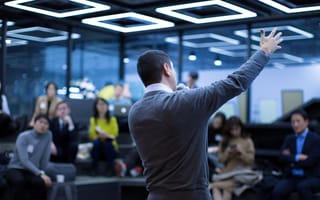It’s an old C-suite adage that if you don’t have the next two (or even three) years planned out for your team, you aren’t doing your job.
Though reality is a little murkier than that — after all, no one could possibly plan out the minutiae of their team’s daily work for the next two years — it’s a truth that rings especially true for leaders of product teams. Product leaders need to understand the long-term goals of their organization inside-out and build every sprint or schedule with those objectives in mind. At the same time, they must also keep an eye out for any emerging innovations — from new frameworks and architectures to the buzzwords everyone loves to hate — that may affect their work, or even the overall trajectory of the company.
To get a sense of how companies are thinking about the evolution of their services, the technology they work with and the trends that affect them both, we checked in with senior product leaders in the e-commerce, logistics and mobility industries. Data processing, robotics and, of course, artificial intelligence — the great accelerator and automator of the early 2020s — feature heavily here, and the insights of these professionals offer a glimpse at what the job requires for any would-be product leaders wondering which skills to cultivate as part of their career development.
Though Hariharan leads e-commerce automation platform CommerceIQ as its chief executive, he comes to the role from a deep product background. His career includes more than five years building out automated vendor management, supply chain and AI-based selling coaches for Amazon, as well as a stint managing “marketplace experience” for eBay.
Based on his considerable experience with e-commerce tech, Hariharan considers artificial intelligence as the transformative engine in the industry right now. “AI, ML and data science will continue to redefine tech solutions, and this is something that every software provider will need as part of their offering,” he said, adding that the SaaS business model will also continue to change how companies consume technologies.
What are the technology trends that will affect the direction of your industry over the next five years?
The use of artificial intelligence is the preeminent technology trend to affect our industry. As e-commerce growth continues to mushroom, AI becomes the enabler to keep up operationally as well as to drive consumer interactions. In fact, there are multiple uses for AI — in chatbots, smart logistics, advertising recommendation engines, personalization and driving efficiency across the e-commerce flywheel — connecting marketing, sales, supply chain and operations. To thrive in e-commerce, consumer brands need to make thousands of real-time decisions across multiple channels. This level of scale is only possible with AI and the automations that it can generate. The winners in our industry will be the ones who can establish a single source of truth that will drive the best recommendations and automations that translate into higher market share and profitability.
As a tech organization, how are you leveraging or anticipating those trends?
During our days at Amazon we witnessed the emergence of algorithms as the way e-commerce was being managed, and we knew that this was the future. So while this trend has been emerging for quite some time, the game-changer for the industry was the pandemic and the way in which it accelerated e-commerce growth — pushing seven years of growth into one.
We have created the first purpose-built automation platform that supports all the elements of the e-commerce flywheel. It starts with connecting multiple data sources to establish a single source of truth, extracts insights and recommendations and then pushes automations at significant scale. This helps brands eliminate many of the inefficiencies they experience in online marketplaces, like managing out-of-stocks and third-party variants. The algorithmic platform we are building makes these types of high-quality decisions at scale, and learns and improves over time as it makes more and more decisions.
“There are not so many other industries — besides maybe financial services — that operate at the same scale and speed.”
How do you think your technology will change over the next couple of years?
AI is a fast-evolving space and we will continue to invest in promising tech that helps us make better decisions. To that end, there are AI frameworks — like GPT-3 or Bert — that our team is actively working towards contributing to mainstream decision-making. As we grow our offering into omnichannel commerce, we will also continue to invest in scaling our cloud native SaaS offering using Kubernetes and infrastructure-as-code technologies.
From a technology perspective, what makes your industry uniquely challenging within the broader tech ecosystem?
Our software needs to make really high-quality and accurate decisions at scale. There are not so many other industries — besides maybe financial services — that operate at the same scale and speed, making the tech challenge significant but also rewarding as we see the ROI that our customers generate in terms of higher sales, profits and overall market share.
Few industries are as complex — or as suited for a tech-driven overhaul — as logistics. Girolamo leads product and engineering teams at Flexe, a Seattle-based company that provides an online marketplace for on-demand warehousing solutions — think AWS or Azure but for physical warehouses rather than server space. The company is growing fast, having recently added $80 million in funding to a war chest that now totals more than $140 million.
Girolamo cut his teeth on Microsoft’s operating system security and cryptography teams before moving to Amazon to work on supply chain and fulfillment technology. For him, innovation at Flexe boils down to two key areas: how to leverage the data they have to bring more value to users, and how to create interoperability between Flexe’s technology and various robotics systems used in logistics facilities.
What are the technology trends that will affect the direction of your industry over the next five years?
The application of data across supply chains will have the largest impact on the logistics industry. The proliferation of IoT devices across manufacturing, trucking and warehouses means that businesses can collect more data from the end-to-end supply chain than ever before. I envision that supply chain leaders will leverage the newly acquired data from sensor technology and lean into data processing to improve forecasting and refine supply chain planning processes.
Another supply chain technology trend to follow will be the continued adoption of AI and machine learning to make operators more efficient and effective. For example, we’re seeing many retailers and third-party logistics warehouses apply robotics to make the fulfillment process less stressful. From robotic arms to goods-to-person systems, robots will change how people lay out their warehouses — and ultimately how goods flow to customers.
COVID-19 illuminated that logistics networks have been optimized for lean, low-inventory operations. However, the onslaught of disruptions last year beckoned a renewed focus on supply chain resilience. In the coming years, businesses must apply data, AI and machine learning to ensure their logistics networks are both lean and resilient.
How do you think your tech stack will change over the next couple of years?
We’re a cloud-first company. The biggest change that will impact our stack is the increased use of data, moving from a traditional, N-tier architecture to an architecture that can process large amounts of real-world sensor data to serve our customers in valuable ways.
I want to revisit this idea of resilience. Our software powers warehouses — it’s critical that our platform is up and running so that our customers can monitor their operations in real time. We’re laser-focused on the current best practices in microservers, network architecture and multi-cloud to ensure consistent uptime and performance. We’re also committed to an open source stack built on multiple clouds.
“Logistics is engaging, unique and (dare I say) fun, and the challenges are a big part of the reason I’ve worked in this space for so long.”
Which key skills should a would-be product leader cultivate to be successful?
The most important skills are curiosity and problem-solving. As a technologist for more than 15 years, I’ve learned that all industries rapidly change and there are always a wealth of things to learn. Possessing a fundamental curiosity about how things work and how things could be better is super important and valuable, especially early in your career. Curiosity will lend itself to critical thinking and a desire to problem-solve. Remember to start with the customer and work backward from their problem. Identify the problem you must solve and ask yourself who it benefits if it’s solved.
From a technology perspective, what makes your industry uniquely challenging within the broader tech ecosystem?
When I first started in the logistics industry I thought, “How hard could it be to move boxes around?” However, I quickly learned that the physical world is messy. Humans are an inevitable part of logistics networks, and humans are imperfect — packages are moved to the wrong place or an errant barcode is scanned. Beyond humans, there’s a plethora of supply chain disruptions out of anyone’s control — trucks break down, and inclement weather delays shipments. Logistics and the movement of physical goods are inherently difficult to predict and model in software.
Writing software to manage business processes at scale is already a massive challenge for any industry. The messy nature of supply chains only further amplifies that challenge. Logistics is engaging, unique and (dare I say) fun, and the challenges are a big part of the reason I’ve worked in this space for so long.
Dockless scooter-sharing company Spin has had a busy pandemic. The San Francisco company partnered with the city of Portland, Oregon as an alternative to public transit during the worst days of the pandemic last year. Recently, it rolled out a new scooter model designed to withstand extreme weather and allow for modular parts-swapping. The company was founded in 2016 and acquired by Ford’s Smart Mobility unit just two years later.
Wong joined Spin as its chief technology officer in 2017, after a stint at Envoy where he helped to build its highly successful deliveries feature. He also spent time in engineering and management at Fitbit and was an entrepreneur-in-residence at Samsung before that.
What are the technology trends that will affect the direction of your industry over the next five years?
Shared micromobility is still in its infancy, even though there has been a lot of attention and focus on it in recent years. I believe that there will be a lot of innovation in both hardware and software technology in the next few years, particularly around making shared mobility safer for riders and pedestrians and making micro EVs available to riders whenever they need them.
How do you think your tech stack will change over the next couple of years?
Machine learning will be core to our business in the coming years, so we're working on scaling out our systems to be able to use ML as an integral part of running our business. We’re constantly talking to our riders and cities as well as seeking out technology partners to better understand how to make our micro EVs safer and more available to riders.
“The combined importance in both software and hardware innovation... makes it very exciting and challenging at the same time.”
What are the key skills would-be product leaders should cultivate to be successful?
Being curious and having the discipline to always solve the toughest problems without giving up.
From a technology perspective, what makes your industry uniquely challenging within the broader tech ecosystem?
What’s unique about tech in micromobility is the combined importance in both software and hardware innovation that makes it very exciting and challenging at the same time.









